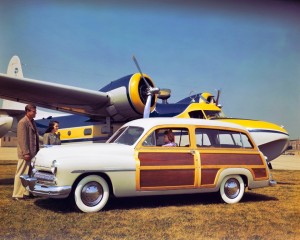
Mercury cars of the 1949-1951 model years, like those of 1939-40, had distinctive bodies that appealed especially to the customizers of Southern California.
The demise of Mercury was a long time coming. To understand it, you have to know a lot about the car’s history, and how things work inside Ford Motor Company.
First the history: During the 1930s, so-called “medium-priced” brands like Buick and Dodge flourished. However, Ford marketed nothing between the basic Ford and the big and expensive Lincoln. For example, 1934 Ford sedans ranged in price from $535 to $625 but the least expensive ’34 Lincoln sedan cost $3,450—a big gap.
So the company decided to plug the gap. The first step to counter General Motors and Chrysler Corporation in the middle of the market was the 1936 Lincoln Zephyr, introduced in the fall of 1935 and priced at $1,320. Buicks for 1936 ranged from $885 to $1,695 for a four-door sedan.
The second step in Ford’s plan was Mercury, introduced in the fall of 1938 as a 1939 model. A four-door Mercury was priced at $957, fitting neatly into the lower-medium priced market, as things were done on those days. About 66,000 were sold the first year. Contrary to popular misinformation, Mercury then was not just a badge-engineered Ford. It had a larger 239-cid, 95-horsepower V8 (versus Ford’s 221 with 85 horsepower), a longer 116-inch wheelbase and a unique, wider body.
Overseas, Mercurys became relatively popular as an upscale car in those European countries without native auto industries, the likes of Norway, Finland, Netherlands, Belgium, Switzerland. Canadian plants assembled right-hand-drive Mercurys for the British Empire market. As an example, the last Ford Motor Company civilian car produced after Pearl Harbor was a Canadian right-hand-drive Mercury built in April 1942 for export to Kenya.
The Lincoln-Mercury Division as a marketing organization was established in 1945, right after the end of World War II. Aping General Motors’ medium-price brands, Mercury was to have its own assembly plants, engineering, purchasing and eventually engines. Benson Ford, Henry II’s younger brother, served as general manager of Lincoln-Mercury until the brands were split into separate divisions in 1955 in an aborted attempt to copy GM further.
Mercurys of the 1949-1951 model years, like those of 1939-40, had distinctive bodies that appealed especially to the customizers of Southern California. Think James Dean. Accordingly, original unaltered versions have long been hard to find, and now will be rarer yet.

Winged no more, as Ford management claims the Mercury brand wont fly, based at least in part on their stewardship.
Ford Motor Company’s mid-Fifties multi-brand scheme, hatched by former GM execs lured to Ford after the war by Ernie Breech, envisioned a Continental Division as a competitor to Cadillac, a Lincoln Division to face off against Buick, the new Edsel Division to counter Oldsmobile and Mercury Division versus Pontiac.
Ford Division of course would continue to compete with Chevrolet in those good old days when the highest selling import was MG. As we all know, the grand plan collapsed when the Edsel became an instant flop at its introduction in 1957.
The cost of the Edsel failure, reportedly $250 million, a lot for the time, undoubtedly stunted Mercury’s plans for a distinct future, though Mercury for a time rode high, from the 1957 through the 1960 model years. In March 1960, Mercury was first to introduce what was tabbed the “first luxury compact,” the Comet with a 114-inch wheelbase up from the Ford Falcon’s 109.5. The Comet originally had been named the Edsel B, perhaps a never-developed plan to continue the brand in some form.
Buick, Olds, Pontiac and Dodge couldn’t counter with their own luxury compacts until the 1961 model year. But in the meantime, Mercury as a separate division had been folded back into first a Mercury-Edsel-Lincoln, or M-E-L Division, and lost all its unique assembly plants and engines. By the 1961 model, the “big” Mercury once more was sharing a Ford body.
Lincoln-Mercury Division, reformed once again, sought a unique feature with the Breezeway Mercury models featuring a power-operated reverse-slant back window that when lowered whisked fresh air through from front vents past the occupants in the days before air conditioning became standard. Generally, Mercury models have featured different greenhouses as well as front and rear designs unique from those of Ford.
Alfred Sloan’s magic money machine of step-up marketing, established by GM in the 1920s, quickly copied by Chrysler and adopted in the Thirties by Ford, began to become undone by Ford’s 1960s balkanization of the market with different sized and priced cars sold in the same brand dealership. No longer were prospective buyers forced to shop different car-make dealers for “step-up.”
As an aside, some critics have dumped on Lincoln-Mercury for feeble success at selling imported Ford products, but the truth is, Ford dealers had the same problem—for instance, the Fiesta of 1979-81. (Corporate planners did not believe that an automatic transmission–for an otherwise great little car–was necessary for the American market.)
Once General Motors under Roger Smith consolidated its formerly independent divisions in the 1980s, Mercury began to lose its reason for existence. The rising tide of imports exacerbated the problem insofar as market share was concerned. Recognizing the problem early after Edsel’s failure, Chrysler had given up on its medium-price DeSoto in 1960, and folded the once strong Plymouth brand 40 years later.
The final nail in Mercury’s coffin ironically was GM’s bankruptcy last year, in which Pontiac was discontinued. Oldsmobile had fallen a few years before. All that is left of the once flourishing medium-price field is Dodge.
That’s the external side of the Mercury saga.
The internal story is one of constant competition between the dominant, family name Ford Division and the struggling Mercury within Lincoln-Mercury Division. In the 1960s, when I worked at Lincoln-Mercury, the competition with Ford Division, rather than with, say, Pontiac was fierce. Managers were raised within the company with an unregistered brand name on them, Ford people or Mercury people. Mercury managers always fought for larger budgets for creating unique, appealing vehicles— but the purse strings always seemed to be held by the Ford Division people.
Later, there was a different aspect to the fight for survival Mercury endured, one that came from top management who originated in Ford of Europe or achieved their greatest success there. They simply could not understand why Ford Motor Company had a two-franchise system in North America.
The first tangible sign of Mercury’s demise was the decision several years ago to eliminate the Lincoln-Mercury franchise in Canada, which is about ten percent the size of the U. S. market. Lincoln dealers were merged with Ford dealers, and Mercury brands like Sable eliminated. The Ford Crown Victoria as a civilian car was ended in Canada, but Ford-Lincoln dealers there continued to sell a “Ford Grand Marquis.” (This nameplate also was exported to places like Mexico.)
The second was the failure to offer a Mercury version of the 2000 Ford Focus.
In the meantime, the company’s strategy evolved. Rather than re-branding an upscale Ford model as a Mercury, it would be called a Lincoln—and priced accordingly. For example, the Lincoln MKX stickers for about $10,000 more than its clone Ford Edge. Had there been a Mercury version, it would have been more like a couple of grand more. Look at the price relationship between Ford Fusion, Mercury Milan and Lincoln MKZ, all essentially the same car. Once the company saw the Lincoln strategy working, the choice was obvious—skip the intermediate slot of Mercury and jump from Ford to Lincoln, acceptable in 2010 when it was not 75 years ago.
Well, all that’s history now. I urge any reader who wants to own a new Mercury to beat a path down to his or her Lincoln-Mercury dealer before the inventory is gone and doors closed. That is also true of anyone who wants a Lincoln Town Car, since production of that model along with Ford Crown Vic taxi and police units will be ended in September of 2011.
Pardon me now while I mourn in peace for my lost love, Mercury. Sob. Of course, I still have my ’65 Mercury Comet Caliente convertible to comfort me. And it’s about time to get it out of winter storage.

Mike, Good article. Thanks for giving us all the story.